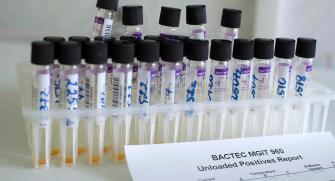Tuberculosis: Improving screening and preventive treatment for contact cases, thanks to community health workers
Despite available evidence and recommendations, contact investigation remains poorly implemented in many high TB incidence and resource-limited countries due to operational challenges such as a lack of financial investments and limited human resource capacity. A key challenge affecting the coverage of contact investigation is the necessity for parents to bring child contacts to the health facility for TB screening and management of preventive treatment of tuberculosis (TPT). Community-based approaches for household child contact management could increase the contact investigation coverage and TPT uptake by bringing those services closer to the people in need and reducing the financial burden.
The CONTACT study is the first cluster randomized controlled trial to evaluate a community-based intervention for tuberculosis screening and TPT management of household child contacts by community-health workers. The study led by the IRD is part of the the Elizabeth Glaser Pediatric AIDS Foundation (EGPAF)’s CaP-Tuberculosis (TB) Project and was funded by global health organization Unitaid. The cost-effectiveness of the CONTACT study intervention was evaluated by the University of Sheffield.
The study compared its effectiveness, feasibility, and cost-effectiveness to the facility-based standard of care. The study was performed in Cameroon and Uganda and shows that community-based contact investigations performed by community-health workers increases the coverage, initiation, and completion of TPT among child contacts under 5 years old or 5-14 years old children living with HIV. The proportion of child contacts of all ages who were screened for TB increased from 47.3% in the standard of care arm to 81.9% in the intervention arm and the proportion of child contacts in the TPT target group that initiated and completed TPT increased from 61.7% in the standard of care arm to 79.9% in the intervention arm.
The intervention prevented 15 tuberculosis deaths in Cameroon and 10 in Uganda. The incremental cost-effectiveness ratio was $620 per disability-adjusted life-year (DALY) averted in Cameroon and $970/DALY averted in Uganda. The intervention in Cameroon and Uganda would be considered cost-effective at willingness-to-pay thresholds of $1,000/DALY averted. In addition, as previously reported the intervention significantly reduced the median household cost as compared to the standard of care in both countries.
The CONTACT study confirms that decentralizing contact investigation at the household level using community-health workers is feasible and effective in improving child contact screening coverage, TPT uptake and completion as compared to facility-based standard of care. Impact and cost-effectiveness of such interventions would be greater in settings with higher TB disease prevalence among contacts and lower for existing coverage of screening for child household contacts. Decentralizing contact investigations at household level is likely to contribute to filling the TB case finding and prevention among children and can play a critical role to reach the targets set for 2027.
crédit Photo : Eric Bouvet
References
Bonnet M, Vasiliu A, Tchounga BK, Cuer B, Fielding K, Ssekyanzi B, Tchakounte Youngui B, Cohn J, Dodd PJ, Tiendrebeogo G, Tchendjou P, Simo L, Okello RF, Kuate Kuate A, Turyahabwe S, Atwine D, Graham SM, Casenghi M, CONTACT study group. Effectiveness of a community-based approach for tuberculosis household child contact investigation and management: a cluster randomized trial in Cameroon and Uganda. The Lancet Global Health, 31 octobre 2023. DOI : 10.1016/S2214-10923)00430-8
Mafirakureva N, Tchounga B, Mukherjee S, Tchakounte Youngui B, Ssekyanzi B, Simo L, Okello R, Turyahabwe S, Kuate A, Cohn J, Vasiliu A, Casenghi M, Atwine D, Bonnet M, Dodd PJ. Cost-effectiveness of community-based household tuberculosis contact management of children in Cameroon and Uganda: modelling analysis of a cluster-randomised trial, The Lancet Global Health, 31 octobre 2023. DOI : 10.1016/S2214-10923)00451-5









